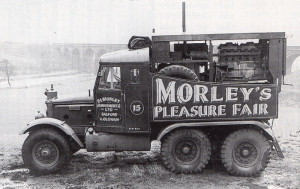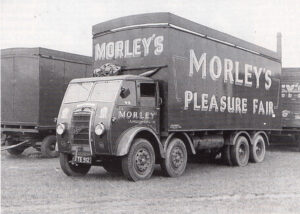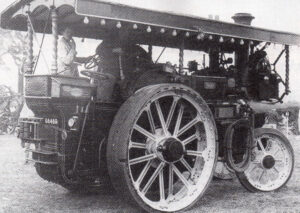
During the later years of the 1940s Northenden was much the same Cheshire village it had been some 20 years before. A few council houses had been built in the Kenworthy Lane area and there was some private building off Longley Lane, the old main road to Gatley, another Cheshire village.
The development was all that showed that the village was now a part of Manchester, and in the county of Lancashire. For over half its length the village street, the main road to Manchester, still had large houses whose gardens ran to the road, and a birds’ nest or two could still be found in the tall trees and high hedges.
Even on the other side of the road, with its rows of small shops, there remained two very large houses, one belonging to Mr. Dale, the village photographer.
Barrow’s Garage was an old stone barnlike building with petrol pumps that would swing high over the pavements when an occasional car stopped at the roadside for a ‘fill-up’.
People still visited Northenden at the weekends to stroll around the lanes or visit the River Mersey for a bit of gentle rowing or a trip in the motor boat towards Didsbury before tea in the little cafe on the river bank at Ford Lane and back to Manchester.
There was always lots of excitement when the Easter Fair came. The enormous motor tractors, which hauled as many as three trailers each, had begun to arrive by the Tuesday and, as in the previous two years, I was allowed to help build up. The largest site, in Mill Lane, was occupied by A. Bates’ three rides which were the main attraction for us teenagers, and which I helped to build up.
Royals’ site on Brown Street was much smaller, with only one ride and a few stalls, but the equipment was still hauled by steam traction engines which also provided the generating power for the galloping horses. Our parents, though, tended to visit Ingham’s on Ford Lane, on ground beside the river owned by Kaye’s.
If the weather was kind, huge crowds would arrive, not only from the village but also from the new Wythenshawe estates of Benchill, Crossacres, Royal Oak, Lawton Moor and Rack House, once the farmlands of Cheshire but now providing the much needed houses for Manchester. Visitors also came from the southern districts of the city for a day in the country. The little village would be packed solid.
It was fine and the crowds came.
Generators hummed, coloured lights glittered, and over all the hustle and bustle came the happy laughter of children and the screams of the girls as the Jungle Ride went faster and faster. The manager, one Mr. Knightley, seemed to know just how fast to run the ride to suit the particular age group aboard.

Stalls were brightly painted for the new season, and better still no sweet coupons were required for the candy floss and toffee apples. Dodgem cars banged together, almost drowning the attendant’s cry of “One way round the track, please!” and older teenagers tried to impress their girl friends with a ride on ‘Over the Tops’. Once started by the attendant, you needed all your strength to keep the cage going, and the screams and happy laughter competed with the hits of the time from George Formby, Bing Crosby, Grade Fields, Arthur Askey and the Andrews Sisters. A newer style of music was creeping in, too – Bingle Bangle Bungle, don’t want to leave the jungle!
The huge crowd moved through the village from site to site, with none of the trouble or unpleasantness that abounds today. It was still the age of the Sunday suit rather than unisex garments, jeans, bomber jackets and the like, and although clothing coupons were still in the mind, the men dressed in their best suits or smart jackets and grey flannels, and the girls in bright dresses or summer blouses and skirts to match the springtime mood.
Many still wore hats, the children’s bought from fairground sellers with ‘Kiss me Quick’ or some other message attached.
As darkness fell, this part of the village, still with its gas street lighting, became a fairyland of bright coloured lights and fairground sounds.
All my friends were there that Easter, both from school and the local ABC Minors cinema club, and I can remember them as if it were yesterday – Dorothy Bell from Northenden, Norma Southwell from Benchill (the first girl I took home for tea, who wore a new heart-shaped hat that Easter), Audrey Byrom, who later became my wife. There was also my school pal Marvin Chorlton, whose family ran the village taxis, lived quite close to the river and knew the Kayes. For part of the fair we all helped with the boats and some of the rides, and the girls helped in the cafe and on the drinks stall serving the huge crowds who were so glad to see the end of the war.

Our whole lives stretched before us then, and the future seemed vibrant, but over the years many of us lost touch, and some moved away from the area. Where are they all now? Did their dreams eventually come true?
The fair no longer comes to Northenden; the boats have gone from the river; the lanes no longer link the villages; a motorway runs across open land on the far river bank; the ABC cinema, which opened only in December 1934, closed its doors many years ago. Both sides of the main street are filled by shops, banks and building society premises, and gone is the local Co-op. The street is also full of cars, taking the Manchester traffic further and further into the Cheshire countryside. Northenden is no longer a village – just part of the vast Wythenshawe estates.
Although my grandparents, parents and friends have all gone, I sometimes visit the church near my school friend’s former house and garage, long swept away, to visit my grandparents’ grave.
Even today, when walking down the streets near the church, I can still hear the noise of the fair and picture friends from my childhood over 50 years ago.
Bryant A. Hill.








